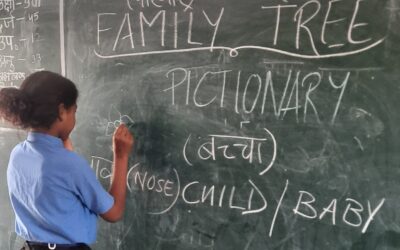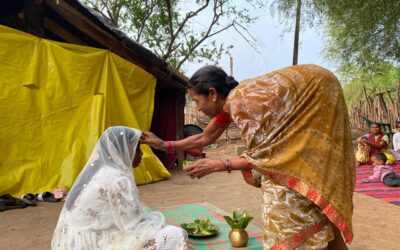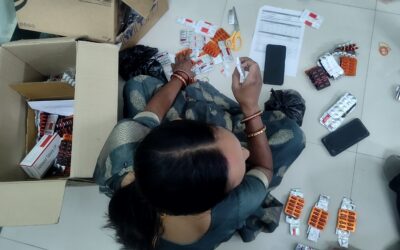Raigad – The first capital of the former Maratha Empire, the land of captivating forts and free flowing streams; the home to picturesque Konkan belt where tribals stay dormant deep inside jungles, as if incongruous. Raigad in Maharashtra is surrounded by Thane and Navi Mumbai on the north, Pune and Ratnagiri on the east and south respectively while the Arabian Sea gently rests on the west. The city starts where the hustle of Mumbai ends or perhaps Mumbai begins where the rustic charm of Raigad ends. It is spread out into 4 sub divisions for administrative convenience, with 15 talukas and 1967 villages.


As per 2011 census, Maharashtra has a population of 11.42 crore of which 9.35% are tribals, categorized as Scheduled Tribes (ST). Maharashtra has the second largest tribal population in the country, next only to neighboring Madhya Pradesh. Raigad has 26.3 lakh people, of which 11.58% are tribals. That’s about a little more than 3 lakh. More than 80% of them are Katkaris.
The Katkari tribes are located primarily in Raigad and in parts of Palghar, Ratnagiri and Thane districts as well and in some places of Gujarat. Katkaris are former criminal tribes under the Criminal Tribes Act, 1871, an inhuman piece of legislation enforced during the British rule. The act describes certain groups of people as “habitually criminal” and puts restrictions on their movements which led to alienation, stereotyping and harassment, to say the least. After independence, the Act was repealed resulting in more than 20 lakh tribal people across the country being decriminalized. However, the stigma associated with the act continues to haunt the Katkaris and several tribals to this day. Presently, the Katkaris are classified as Particularly Vulnerable Tribal Groups (PVTGs). The Government of India came up with this classification to introduce targeted interventions noting that some tribal groups had the least development indices as compared to other tribal groups. The criteria used by the state for classifying PVTGs was as follows:
- A pre-agricultural system of existence such as hunting, gathering
- Zero or negative population growth
- Extreme low level of literacy in comparison with other tribal groups
- A subsistence level of economy
Groups that satisfied any one of the above criterion were considered a PVTG. There are more than 700 tribal groups in India and only 75 are classified as PVTG. Maharashtra is home to three such groups.


Photo credits: Center for Social Action Database
During my initial days in Mangaon, I could not believe that people lived in such extreme poverty so close to urban mega cities and still somehow go unnoticed. I started looking up the development indices. Maharashtra is the fastest growing state in India. Its GDP is 360 billion USD and for comparison, the second in line is Tamil Nadu, much behind at a GDP of 230 billion USD. As of 2011, Maharashtra’s HDI was 0.752. Raigad’s HDI in the same period was 0.759. Now, that’s higher than the state’s!
Data master, Hans Rosling said that it is dangerous to look at average data because often there is a huge difference within.
Katkaris were historically forest dwellers. The name Katkari is derived from a forest based activity – the making and barter or sale of Katechu (kath) from the khair tree (Acacia Katechu). It is produced by boiling wood from the Khair tree and evaporating the resulting brew.
This makes an astringent used in Ayurvedic medicine and in mixtures chewed with betel leaves. The Katkaris were also one of the few tribal communities of India that consumed rodents. However, it is not clear if this practice still continues. The most common surname is Waghmare which means tiger slayer. They are bilingual, speaking the Katkari language amongst themselves and Marathi with others. A few of them speak Hindi as well. Today, most Katkaris have migrated from their forest dwellings to the plains while some hamlets are located on the hills. Upon my visits to a few tribal hamlets, an apparent division was evident. Almost every tribal hamlet is located on the boundary of the main non-tribal part. These tribal hamlets are suffixed with the term ‘Adivasi’. Ex., Warak Wadi and Warak Adivasiwadi. The village cement road ends where the Adivasiwadi begins and seldom has water connection and/or electricity. Schools and community centers are also located in the main village. This is an indication of physical exclusion.



Like most tribal communities, Katkaris are plagued with the issue of landlessness and subsequent distress migration. Most literature on the Katkaris cite landlessness as the single biggest problem making them vulnerable and deprived. The landless rate of 87% among the Katkari is much higher than 48% for rural households in India as a whole. The Forest Rights Act, 2006 rules that traditional forest dwellers shall have the right to hold and live in forest land under the individual or common occupation for habitation or for self-cultivation for livelihood.
Despite over a decade into force, only 13% of the Katkaris have been assigned forest land. As a result of landlessness, migration is rampant and livelihoods are seasonal. During the agricultural season of May to October, they work as laborers in the fields of Marathas which they deem as their golden period of the year and hence, life. They earn a wage of Rs. 300 per day along with lunch and tea. They also catch fish and crabs during this season which they sell in the nearby towns. Some income also comes from minor forest produce. In the months from November to April, most of them migrate to become brick kiln workers or daily wage laborers. Bonded labor is prevalent and living conditions are dismal.
Topping everything, Katkaris face eviction of all forms. Selective development brings its own bag of problems. The rapid rise of Mumbai and surrounding areas led to skyrocketing land prices leading to landholders selling off land to corporates and developers. This land is in close quarters to tribal settlements and tribals are constantly intimidated to move to different locations. While India propels towards underground bullet trains, a section of the society is in that underground, waiting and dreaming of living a life above.
References
1. Buckles, D., & Khedkar, R. (2013). Fighting Eviction: Tribal Land Rights and Research-In-Action.
2. Tata Institute of Social Sciences (2014). Socio-Economic Issues Facing Katkaris
3. Dr. Bhimrao Donde, S., & Doongursee M, K. (2014). Dhor Katkari: The Ecosystem People Facing the Threat of Extinction




Thoroughly enjoyed reading it. Also like i said before, its unique how the CSA fellows always refer to the tribe by their name and not as community …